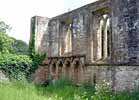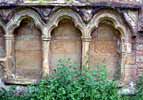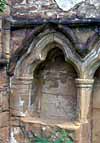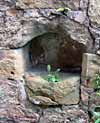For this church:    |
| |||||||
 |
 |
 |
| Location and detail of the sedilia and piscina in the Lady Chapel | ||
There is a three-seat sedilia in the south aisle, with an integrated piscina.
Siveyer dates this Sedilia / Piscina in the Lady Chapel to 1220-1240, more than a century earlier than the construction of the wall into which it is built. She concludes that it must have been moved from elsewhere, but finds no evidence that it could ever have been sited in the Chancel. Since sedilia and piscina are intended for the exclusive use of the clergy, this latter positioning is the only one possible. Since the Lady Chapel was a Chantry Chapel, looked after by the canons of Felley (indeed, the Chapel was often referred to as the “Felley Chapel”) there must be a strong possibility that this artifact was brought from Felley and installed at Annesley some 150 years after it had been made. Confirmation that the Sedilia / Piscina was built in to the South wall of the Lady Chapel during initial construction, rather than transferred and inserted later, arises from the fact that the string courses on both the inside and the outside of the South wall follow identical paths around the top of the Sedilia and its Piscina.
Piscina
 There is a piscina in the chancel of a much more rudimentary type than the
one in the Lady Chapel.
There is a piscina in the chancel of a much more rudimentary type than the
one in the Lady Chapel.
High Altar
The High Altar was removed to the new church of Annesley All Saints, where it may be seen in the Lady Chapel. It probably dates from the 17th Century.
Norman Font
 The Norman font The Norman font |
The Norman font is described in the visitor leaflet as 11th century, but the Revd AMY Baylay, in his Lecture to the Thoroton Society of 1912, regarded it as 12th century and stated that it was made for the “Norman Church”, which was erected in about 1150. It was transferred into the Old Church beside the Hall in 1356.
In 1924, the Revd GA Lejeune, Vicar of Annesley All Saints, together with William Waplington and Arthur Colledge, Churchwardens, petitioned Edwyn, Lord Bishop of Southwell, for permission to move it, and that was done. It is thus now in the New Church.






